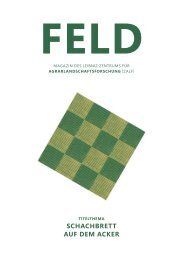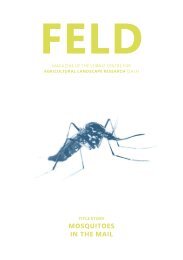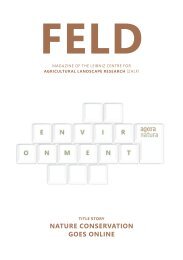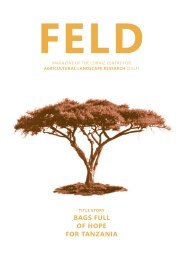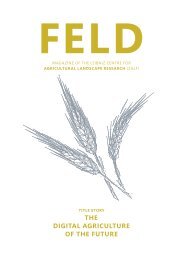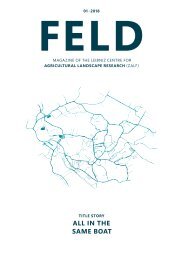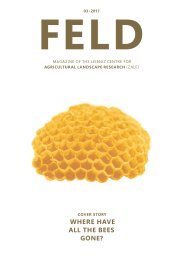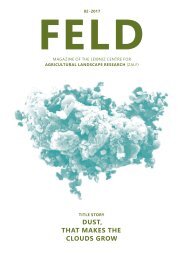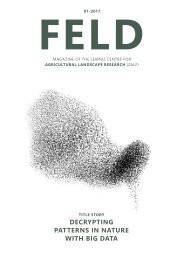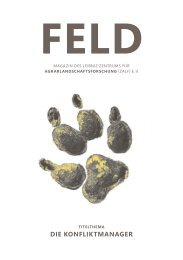FELD 02/2020
When wild animals and agriculture meet, there are often conflicts. Hannes König is working on new instruments for wildlife management to change this. // Crop residues can have a major impact on soil fertility and emissions footprint. How can these residues be used efficiently? Tommaso Stella and Ioanna Mouratiadou are exploring this question. // When Gabriela Onandia walks through Berlin, she recognizes a large number of ecosystems where most people only see parks or green areas. The scientist is investigating the effects of urbanization on these ecosystems. // Soils fulfil many functions that are extremely important for humans. Michael Sommer and Martin Leue try to extract as much information as possible from these all-rounders.
When wild animals and agriculture meet, there are often conflicts. Hannes König is working on new instruments for wildlife management to change this. //
Crop residues can have a major impact on soil fertility and emissions footprint. How can these residues be used efficiently? Tommaso Stella and Ioanna Mouratiadou are exploring this question. //
When Gabriela Onandia walks through Berlin, she recognizes a large number of ecosystems
where most people only see parks or green areas. The scientist is investigating the effects of urbanization on these ecosystems. //
Soils fulfil many functions that are extremely important for humans. Michael Sommer and Martin Leue try to extract as much information as possible from these all-rounders.
Create successful ePaper yourself
Turn your PDF publications into a flip-book with our unique Google optimized e-Paper software.
<strong>FELD</strong><br />
MAGAZINE OF THE LEIBNIZ CENTRE FOR<br />
AGRICULTURAL LANDSCAPE RESEARCH (ZALF)<br />
TITLE STORY<br />
THE CONFLICT MANAGERS
Issue <strong>02</strong> · 2<strong>02</strong>0<br />
SUSTAINABLE DEVELOPMENT GOALS<br />
CONTENT<br />
17 »Sustainable Development Goals« are the centerpiece of the Agenda<br />
2030, approved in 2015 by the United Nations (UN). The Agenda lays a<br />
foundation for global economic development in accordance with social justice<br />
and within the ecological boundaries of planet earth.<br />
MORE INFO<br />
https://sustainabledevelopment.un.org/sdgs<br />
When WILD ANIMALS and AGRICULTURE meet, there<br />
are often CONFLICTS. Hannes König is working<br />
on NEW INSTRUMENTS FOR WILDLIFE MANAGEMENT to<br />
change this.<br />
<strong>02</strong><br />
The research projects presented in this issue address the following<br />
Sustainable Development Goals:<br />
2 7 9 11<br />
CROP RESIDUES can have A MAJOR IMPACT ON SOIL<br />
FERTILITY AND EMISSIONS FOOTPRINT. How can<br />
these residues be USED EFFICIENTLY? Tommaso<br />
Stella and Ioanna Mouratiadou are exploring<br />
this question.<br />
10<br />
ZERO HUNGER<br />
AFFORDABLE AND<br />
CLEAN ENERGY<br />
INDUSTRY, INNOVATION<br />
AND INFRASTRUCTURE<br />
12 13 15<br />
SUSTAINABLE CITIES<br />
AND COMMUNITIES<br />
When Gabriela Onandia walks through BERLIN,<br />
she recognizes a large number of ecosystems<br />
where most people only see parks or green areas.<br />
The scientist is investigating the EFFECTS OF URBA-<br />
NIZATION ON THESE ECOSYSTEMS.<br />
20<br />
RESPONSIBLE CONSUMPTION<br />
AND PRODUCTION<br />
CLIMATE ACTION<br />
LIFE ON LAND<br />
SOILS fulfil many functions that are extremely<br />
important for humans. Michael Sommer and<br />
Martin Leue try to EXTRACT AS MUCH INFORMATI-<br />
ON AS POSSIBLE from these all-rounders.<br />
30<br />
INTERVIEW 28 · NEWS 34 · IMPRINT 36<br />
01<br />
Subscribe to<br />
<strong>FELD</strong> free of<br />
charge? Just send a<br />
mail to<br />
feld@zalf.de
TITLE STORY<br />
THE<br />
CONFLICT MANAGERS<br />
9 15<br />
Farm land is also a habitat for wild animals, some of which pose<br />
major challenges to agriculture. They cause damage to seeds and<br />
crops or kill farm animals. ZALF researcher Hannes König and his<br />
junior research group “Human-Wildlife Conflicts in Agricultural<br />
Landscapes” are working on new instruments for wildlife management<br />
to minimize these conflicts. Their research focuses on<br />
the biology and social acceptance of wolf, wild boar, European<br />
bison and co.
wildlife management<br />
wildlife management<br />
For some people it is a moment of happiness, others feel fear or even anger<br />
– the sight of a wolf in the wild provokes a wide variety of reactions. The<br />
predator was eradicated in Germany in the 18th century. Since the 1990s,<br />
wolves have gradually been returning and reclaiming large areas of their<br />
former habitat. More than 100 packs have now made themselves at home<br />
in Germany. The fact of this strictly protected species reproducing here is a<br />
success story for environmental protection. Livestock farmers, on the other<br />
hand, are generally less enthusiastic and view the return of the wolf with<br />
great concern. They fear for their livelihood if sheep or calves are killed on<br />
their pastures.<br />
AGRICULTURAL LAND AND HABITAT<br />
The agronomist Dr. Hannes König is researching conflicts like these. He<br />
heads the junior research group “Human-Wildlife Conflicts in Agricultural<br />
Landscapes”, (LandSTRAT), at the Leibniz Centre for Agricultural Landscape<br />
Research (ZALF). Since 2017 the team has been investigating land use conflicts<br />
between humans and wildlife on agricultural land. In a number of projects,<br />
researchers in biosphere reserves in Germany and Sweden are identifying<br />
when and where damages occur, who is affected and how to reduce the risk.<br />
The wolf is probably the most prominent example of how the debate<br />
on conflicts between humans and wildlife is sometimes conducted in a very<br />
emotional way. But it is not only the wolf leading to conflicts in agricultural<br />
landscapes. Cranes and wild boar are not always met with approval by farmers<br />
either. Wild boars root through the soil with their trunks in search of worms<br />
and insects and dig up the ground thoroughly. After an extensive nightly feast,<br />
a sounder of several animals leaves a field of devastation. Neither meadows<br />
nor pastures, cereal or corn fields are safe from them.<br />
There is also trouble with the crane: especially in spring, when the<br />
large migratory birds return to their breeding grounds from the south. The<br />
seeds and seedlings in the freshly cultivated fields are a welcome food source.<br />
“Massive damage can be caused, especially to maize, legumes and crops such<br />
as potatoes and peas”, says Hannes König.<br />
Cranes on a harvested stubble field (above) and a herd of European bison on a field (below)<br />
4 5
wildlife management<br />
wildlife management<br />
DAMAGE CAUSED BY WILDLIFE IS LESS THAN DAMAGE<br />
CAUSED BY CLIMATE CHANGE<br />
In order to assess the extent of the conflicts and damage, the research team<br />
interviewed about 40 farmers who cultivate land in the Schalsee Biosphere<br />
Reserve in Germany and the Kristianstad Vattenrike Biosphere Reserve in<br />
Sweden. At the same time, they set up more than 60 photo traps at Schalsee<br />
and spent 14 months observing the activity patterns of wildlife in the various<br />
protection zones. The evaluation of many thousands of pictures enabled<br />
researchers to determine were the animals can be found, based on landscape<br />
structures, weather data and even the moon phases.<br />
The interviews showed the damage caused by wildlife is perceived<br />
very differently. Whereas losses due to eating or rooting are insignificant for<br />
some farmers, for others the losses are considerable. However, it is noteworthy<br />
that the damage caused by wildlife is not the main concern for the farmers<br />
surveyed. It is rather droughts, floods, climate change and also price fluctuations<br />
on the markets reducing their incomes much more than wild boars<br />
and seed-eating cranes. The drought year of 2019 shows the damage caused<br />
by climate change and wildlife may accelerate its effect: Many small water<br />
bodies in which cranes usually breed had dried out due to the lack of rain.<br />
As a result, the animals which did not have to look after their offspring, flew<br />
to the surrounding fields and ate their fill.<br />
The wild boars also benefit from the increasingly mild winters. Their<br />
populations are growing massively – and with them the damages. The research<br />
group’s photo traps reveal where wild boars are particularly fond of staying:<br />
at the border between forest and field, where the protective cover of the forest<br />
and the food sources on the fields are close together.<br />
HUNTING AS A LAST RESORT<br />
But how can systematic monitoring lead to improved wildlife management<br />
which minimizes damage to agriculture while protecting endangered species?<br />
“We identify times and areas where conflicts can occur more frequently – for<br />
example due to the life cycle of the animals, seasons or landscape structures”,<br />
explains Hannes König. Hunting seasons and methods can be adapted wherever<br />
extensive damage is likely. Targeted measures to scare the animals away<br />
or diversionary feeding can protect the fields from the worst of the damage.<br />
In Sweden, incoming cranes have been kept away from fresh seeds for years<br />
by feeding them on selected areas. Initial trials in Germany also appear to<br />
be successful. In addition, experiments are being conducted with modified<br />
sowing times and depths to protect the seeds. Compensation payments from<br />
public authorities are also calming down conflicts.<br />
Hunting of the cranes is possible as a last resort in Sweden, but this<br />
is strictly regulated and only allowed with a permit. “This happens rarely”,<br />
stresses Hannes König. “Diversion feeding works as damage prevention, and<br />
in case it does not, a contact person and a transparent system for compensation<br />
payments are in place.” Germany is now taking a similar approach to<br />
wolf management. Last years amendment to the Federal Nature Conservation<br />
Act allows wolves to be shot when farm animals are killed repeatedly.<br />
“Brandenburg has not made use of this so far”, says Hannes König. “However,<br />
livestock owners now have an instrument in their hands for emergencies and<br />
no longer feel they are being left alone.”<br />
An anesthetized young European bison is being collected as part of a pending resettlement. This<br />
resettlement will be accompanied by a medical examination, after which the bison will be equipped with<br />
a telemetry transmitter to track the animal’s movements in real time.<br />
6 7
wildlife management<br />
wildlife management<br />
At the moment the team is still evaluating the night shots. These should<br />
show when and where wild boars are active at night so they can be hunted<br />
efficiently. Full moon nights play a special role here, because without night<br />
vision equipment hunting is only possible in moonlight. The researchers want<br />
to find out whether the animals have become more cautious as a result of their<br />
experiences on nights of the full moon.<br />
The story of a strictly protected European bison which immigrated from<br />
Poland three years ago shows that reaching for a rifle can also be premature. “A<br />
few hours after its arrival, it was illegally shot by hunters in Brandenburg”, says<br />
Hannes König. A mistake that also occurred due to inconsistent instructions<br />
from authorities and misunderstandings in the reporting chain. By setting<br />
up a European bison management system, the aim is to be better prepared<br />
in future as well as to prevent possible damage. “It is likely for the European<br />
bison to re-establish itself in Germany”, predicts König. “In western Poland<br />
alone, near the German border, there are now around 300 animals.” The colossuses,<br />
which weigh up to a ton and are thus larger than their relative, the<br />
American bison, can be dangerous, particularly for traffic. The same applies<br />
to the moose, which is also gradually returning to Germany. “This is why we<br />
must recognize the potential for conflict and develop plans for management”<br />
explains the researcher.<br />
data also shows the wolves often being found in areas where wildlife populations<br />
are high and where food can easily be found. However, in areas where<br />
the wolf likes to stay, it also kills more farm animals. Hunting deer, stags, or<br />
wild boar more intensively where possible would be a measure to make a<br />
region less interesting for wolves and would protect grazing animals. The researchers<br />
now want to verify this thesis with further data. Nevertheless, with<br />
the return of the wolf, our way of keeping livestock on pastures has to change.<br />
Particularly in landscapes with high wolf density, electric fences and livestock<br />
guardian dogs are necessary to make it as difficult as possible for the wolf to<br />
hunt grazing animals. “These protective measures must be consistently implemented<br />
by the livestock owners”, emphasizes König and is now starting to<br />
observe a change in thinking. “It takes time, persuasion and also experience,<br />
but an effort well spent, as it can reduce and minimize conflicts in the future.“<br />
LIVESTOCK FARMERS FACE CHALLENGES<br />
In order to collect the necessary data, the researchers are equipping up to 30<br />
European bison and moose that are living close to the border between Poland<br />
and Germany with transmitters. In this way they can determine the migration<br />
routes of the animals and compare them with land use data to find out where<br />
the animals prefer to be. The transmitters could also be used as early warning<br />
systems, which show in real time when an animal approaches the border, a<br />
field, or a busy road. Examples of successful European bison management in<br />
Poland, where the rare animals are driven from arable land using drones, also<br />
show how conflicts can be avoided. “We can learn from this to develop scientifically<br />
based instruments for wildlife management”, explains Hannes König.<br />
While the European bison and moose are still rarely considered a<br />
nuisance in Germany, the image of the wolf has already been considerably<br />
damaged. Often unjustly, says Hannes König. “Livestock killings in a wolf ’s<br />
territory are more likely to be random events. Food analyses show over 95<br />
percent of wolf ’s prey consists of wildlife”, he explains. The research group’s<br />
THE AGRONOMIST<br />
Dr. Hannes König is head<br />
of the junior research group<br />
“Human-Wildlife Conflicts in<br />
Agricultural Landscapes” at ZALF.<br />
www.zalf.de/feld/en<br />
8 9
USING CROP<br />
RESIDUES MORE<br />
EFFICIENTLY<br />
2 7 9 12 13 15<br />
They are left over after harvest: crop residues such as straw or<br />
leaves. What happens to this material now can have a great influence<br />
on the humus content of the soil and thus on its fertility, as<br />
well as its climate footprint. Researchers at ZALF are looking for<br />
ways to make the best use of the crop residues from our fields.<br />
10 11
crop residues<br />
crop residues<br />
Once the combine harvester has cut the cereals, removed the grain from the<br />
husks and loaded the harvest onto the trailers for transport, the field becomes<br />
quiet. What is left behind are dead plant remains, stubble, straw, and roots in<br />
the soil. The straw is often later pressed into bales and used as animal beddingin<br />
the stables. Some of it however, is also chopped into small pieces during<br />
the harvest and remains on the field. Then countless worms, woodlice, bacteria,<br />
and fungi attack the valuable food. An entire army of soil organisms<br />
decomposes the plant material, drags it into underground passages, crushes<br />
it and digests it into humus.<br />
Like a sponge, the humus in the soil stores water and nutrients. Farmers<br />
calculate how they can balance the content of this valuable substance,<br />
which experts also call “organic matter” using the so-called humus balance.<br />
The type of cultivation, the crops grown, the fertilization and many other factors<br />
determine the build-up and depletion of humus. The higher its content,<br />
the more fertile and healthy the soil. “There is a long list of positive effects”,<br />
stresses agricultural ecologist Dr. Tommaso Stella. “These range from increased<br />
water storage capacity to protection against erosion.”<br />
SOILS IN BALANCE AND THEIR ROLE AS CARBON SINKS<br />
Dr. Ioanna Mouratiadou and Dr. Tommaso Stella, together with colleagues<br />
from the Universities of Utrecht and Bonn, are conducting research in the<br />
EU-funded “SUSTAg” project into the role of crop residues in the carbon balance<br />
of the soil. At the same time, they want to find out how the material can<br />
best be used for the production of bioenergy without harming the soil. “As a<br />
bioenergy resource, crop residues could make an important contribution to<br />
achieving the goals of the 2015 UN Climate Change Conference by reducing<br />
emissions from fossil fuels”, says Mouratiadou.<br />
One of the initiatives launched at the 2015 UN Climate Change<br />
Conference was the “4 per 1000” initiative, which aims to increase the proportion<br />
of organic carbon in the upper soil layers by 0.4 percent every year.<br />
Growing plants extract carbon dioxide from the air through photosynthesis,<br />
use the converted carbon for their growth and release oxygen back into the<br />
atmosphere. If this plant material is permanently stored as organic carbon<br />
in arable land, it removes climate-impacting carbon dioxide from the earth’s<br />
atmosphere. This could offset some of the CO2 emissions caused by human<br />
activity and very effectively protect the climate. At present, however, most<br />
agricultural soils lose more organic carbon than they bind – the balance is<br />
negative in many places. It is therefore important to consider very carefully<br />
whether crop residues should be used for bioenergy production or whether<br />
it is better to leave them on the fields.<br />
CROP RESIDUES AS AN ENERGY RESOURCE<br />
Earthworms (left) and other soil organisms decompose the crop residues,<br />
pulling them into underground passages and crushing and<br />
digesting them into humus (right).<br />
“Generating energy from crop residues has a major advantage in that there is<br />
no competition between food production and energy production”, explains<br />
Mouratiadou. This is different, for example, in the case of maize cultivation,<br />
where large areas of arable land are used solely for biomass production<br />
for biogas plants and are therefore no longer available for food production.<br />
“However, if too much material is taken from the field, the carbon content<br />
decreases, which in turn has an effect on the fertility of the soil and its capacity<br />
to sequester carbon”, is how the agricultural economist explains the conflict.<br />
In interviews with farmers, authorities and associations in North Rhine-Westphalia,<br />
the scientists asked what barriers and concerns are currently preventing<br />
that bioenergy is being generated from the material. It turned out that the fear<br />
of losing humus and thus soil fertility is indeed the greatest concern.<br />
12 13
crop residues<br />
crop residues<br />
Optimized management is needed to<br />
achieve a good balance between soil<br />
health and energy exploitation.<br />
DR. IOANNA MOURATIADOU<br />
The part of the crop residues that is not left on the<br />
fields is used, among other things, as mulch cover<br />
for strawberry fields.<br />
This is why farmers leave some of the plant remains on the fields to rot after<br />
harvesting in order to preserve the humus in their soils. The remainder ends up<br />
primarily as lanimal bedding in stables or becomes a substrate for mushroom<br />
cultivation or mulch cover for strawberry fields. These competing forms of<br />
use, but also the technological limitations and lack of financial incentives lead<br />
to the fact that harvest residues have so far been used little to generate energy.<br />
But Mouratiadou is convinced there is still room for development in<br />
this system. “Optimized management is needed to achieve a good balance<br />
between soil health and energy exploitation”. The researchers used mathematical<br />
models and various management scenarios to determine what form such<br />
management could take, in which the crop residues could be used for energy<br />
production with the lowest possible emissions and without harming the soil.<br />
DECISION-MAKING AIDS FOR FARMERS<br />
“There is no one-size-fits-all solution for the best management”, emphasizes<br />
Tommaso Stella. Agricultural systems are complex. Climate, soil, type of<br />
land use – all these factors influenc emissions, yields and the carbon cycle.<br />
14 15
crop residues<br />
crop residues<br />
Mathematical simulations help to calculate the best possible measures. Soil<br />
composition is proving to be an important factor: “On sandy soils, it may even<br />
make sense to leave all the biomass from crop residues in the fields”, says Stella.<br />
Until now, soil properties, for example, have hardly been considered in the<br />
humus content balances. Yet it makes a big difference whether a farm in the<br />
sandy Uckermark or on the rich soils of the Magdeburger Boerde plows its<br />
crop residues under. The researchers recommend that the type of soil should<br />
be taken into account in the humus balance.<br />
However, the scientists also stress that the appropriate management<br />
of crop residues alone will not suffice to solve the problem of the declining<br />
humus content. How the soil is cultivated and fertilized, or which catch crops<br />
are grown – these are all important pieces of the puzzle that are decisive for<br />
the overall picture. “Our simulations provide information on how the systems<br />
react to certain changes and enable better predictions to be made”, says Stella.<br />
On sandy soils, it may even make<br />
sense to leave all the biomass from<br />
crop residues in the fields.<br />
DR. TOMMASO STELLA<br />
After harvesting, farmers leave<br />
some of the plant remains on<br />
the fields to rot in order to preserve<br />
the humus in their soils.<br />
For farmers, this can lead to useful tools and decision-making aids that indicate<br />
under which conditions crop residues can be used for bioenergy or when<br />
they are better left on the field. “It also depends on what farmers and society<br />
want for their farm and for their region”, Mouratiadou emphasizes. “There are<br />
complex interactions between economic factors, emission levels, soil health,<br />
water quality and much more.” Agricultural land is not all the same and its<br />
use is different. A management system balancing these different demands is<br />
needed. Stella and Mouratiadou’s research shows that an integrated, site-specific<br />
management of crop residues based on humus compensation, optimized<br />
fertilization and winter soil cover offers the greatest potential for balancing<br />
these conflicts of interest.<br />
THE RESEARCHERS<br />
Dr. Ioanna Mouratiadou<br />
works in the Working Group<br />
“Provisioning of Ecosystem Services<br />
in Agricultural Systems” at<br />
ZALF. Dr. Tommaso Stella conducts<br />
research in the Working<br />
Group “Integrated Crop System<br />
Analysis and Modelling”.<br />
16 17
Insect protection<br />
Insect protection<br />
WHAT WE CAN DO TO<br />
MAKE INSECTS FEEL MORE<br />
AT HOME IN LANDSCAPES<br />
Insects have a hard time in our agricultural and cultural landscape. Their<br />
number and diversity have been declining for decades. For this reason ZALF<br />
is working together with other partners from science and agriculture on an<br />
insect protection program for Brandenburg. On behalf of the Brandenburg<br />
Ministry of Agriculture, Environment and Climate Protection of the State of<br />
Brandenburg, a catalogue of measures for the protection of their habitats is<br />
being developed for an entire federal state by representatives from science,<br />
agriculture, nature conservation and politics.<br />
Reduce light pollution<br />
Field margins, fallow land, and insectfriendly<br />
roadside greenery<br />
Insect-friendly mowing<br />
& grazing<br />
Maintain old<br />
trees and<br />
dead wood<br />
Buffer strips<br />
around<br />
water bodies<br />
Varied crop rotations & perenial<br />
leguminous feeding crops<br />
Maintain/restore special<br />
insect habitats<br />
Use less pesticide &<br />
nitrogen fertilizer<br />
Strengthen<br />
organic farming
THE CITY PARK AS<br />
AN ECOSYSTEM<br />
11 13 15<br />
Every day we humans change the image of our environment. This<br />
influence is particularly intense in urban areas. Here, emissions<br />
and the degree of soil sealing by building development are particularly<br />
high. In a study conducted in Berlin, ZALF researchers<br />
are investigating how urbanization affects important ecosystem<br />
functions of green spaces in our cities.<br />
20 21
Ecosystems<br />
Ecosystems<br />
When Gabriela Onandia walks through the capital, she sees the city through<br />
the eyes of a biologist. What she sees are habitats shaped by traffic, buildings,<br />
streets and artificially created green spaces. She sees ecosystems being shaped<br />
and intensively used by humans, which can nevertheless be surprisingly diverse.<br />
Gardens and parks, forest clearings and even cemeteries – these are the<br />
kinds of grassland areas that Onandia’s research looks at more closely – and<br />
for that she has to identify and measure herbs as well as grasses.<br />
“Grassland areas are an important part of the city, but their ecosystem<br />
functions are not very well researched”, explains the scientist. In a study conducted<br />
by the BMBF-funded research project „BIBS“, she and her team are<br />
investigating what these ecological systems look like and how they function<br />
in the city, which biotic communities they characterize and which ecosystem<br />
services – such as the binding of carbon dioxide and the regulation of the<br />
water balance – they provide for people.<br />
“Urbanization is rapidly changing natural ecosystems around the<br />
world”, says Gabriela Onandia. The results of her study provide new insights<br />
into whether the functions of ecosystems in the city are changing, how they<br />
respond to rapid change, and how they can be protected better. The researchers’<br />
statements are also interesting for urban planning – after all, urban<br />
green space is used intensively for leisure and recreation, while at the same<br />
time influencing groundwater and air quality as well as the climate in the city.<br />
The researchers were also able to demonstrate another connection,<br />
already known from habitats that are little influenced by humans, in Berlin’s<br />
urban grassland ecosystems: The greater the biodiversity, i.e. the more plant<br />
species that occur in a given area, the greater the above-ground biomass. This<br />
is an important parameter for ecologists, as it allows statements to be made<br />
about important ecosystem functions.<br />
“Different species use different resources”, is how Gabriela Onandia<br />
explains the positive correlation. For example, while one species only develops<br />
shallow roots and primarily uses nutrients and water from the upper<br />
soil layers, the neighboring species roots deep into the soil and thus uses other<br />
sources of nutrients. “Depending on local conditions, higher biodiversity can<br />
thus contribute to the stability of the ecosystem, as some plant species survive<br />
better than others, for example during longer periods of drought or heat”,<br />
adds Prof. Gunnar Lischeid, who heads the ZALF working group in which<br />
Gabriela Onandia is doing her research.<br />
HIGH BIODIVERSITY, MORE STABLE ECOSYSTEMS<br />
In a field study, Gabriela Onandia examined the water balance, the nitrogen<br />
cycle, the biomass and the species composition at 20 selected locations in<br />
Berlin – including the Tempelhof Field, the Johannisthal Landscape Park in<br />
Adlershof or the St. Hedwig Cemetery in Reinickendorf. In doing so, she discovered<br />
a striking number of plants that are not native to the region. Experts<br />
refer to these immigrant species as “neophytes”, some of which have been<br />
spreading in their new home for many decades. Canadian goldenrod, hoary<br />
alyssum or Canadian horseweed seem to feel particularly comfortable in the<br />
urban environment. About one third of the perennial species included in the<br />
study were non-native. Previous studies suggest neophytes can alter important<br />
ecosystem functions, which makes them particularly interesting for ecological<br />
research. One explanation for why neophytes are so successful in urban<br />
grassland could be that they find a greater variety of habitats in urban areas<br />
than in the rural agricultural landscapes, which are more likely to be cleared. .<br />
The researchers take samples on a grassland area.<br />
22 23
ecosystems<br />
ecosystems<br />
N<br />
Green spaces surveyed in Berlin<br />
1<br />
14<br />
2<br />
3<br />
4<br />
5<br />
6<br />
7 8<br />
10 11<br />
15<br />
16<br />
12<br />
19 20<br />
9<br />
13<br />
1. Spandauer Forst<br />
2. Tegeler Forst<br />
3. Golgatha-Gnaden & Johannes-Evangelist-Cemetery<br />
4. Cemetery St. Hedwig<br />
5. Park at Nordbahnhof<br />
6. Internationales Congress Center ICC Berlin<br />
7. Northern parts of Grunewald<br />
8. Flaschenhalspark<br />
9. Schmetterlingswiesen<br />
10. Autobahn 103 at Schöneberg<br />
11. Tempelhofer Feld<br />
12. Biesenhorster Sand<br />
13. Kaulsdorf-Süd Mahlsdorf-Süd Forst<br />
14. Western parts of Grunewald<br />
15. Natur-Park Schöneberger Südgelände<br />
16. Western parts of Volkspark Wuhlheide<br />
17. Southern parts of Grunewald<br />
18. Southern parts of Lichterfelde<br />
19. Landscape park Johannisthal / Adlershof<br />
20. Fritz-Lesch sports field<br />
17<br />
18<br />
0 1 2 3 4 5<br />
km<br />
24 25
ecosystems<br />
ecosystems<br />
It is important to recognize the value<br />
of urban green spaces and to preserve<br />
them.<br />
DR. GABRIELA ONANDIA<br />
NEW ENVIRONMENTAL CONDITIONS AFFECT ECOSYSTEM<br />
FUNCTIONS<br />
Life in the city is characterized by numerous influences that do not exist<br />
outside of large settlements and traffic routes: Large buildings shade areas<br />
for long periods of the day, increasing traffic pollutes the air quality with<br />
high emissions, more and more surfaces are sealed with asphalt and are thus<br />
impermeable to water. Such city-related, comparatively new environmental<br />
factors significantly influence the water and nutrient cycle of grassland areas,<br />
the study’s data show.<br />
The researchers determined the water-use efficiency of the plants, which<br />
increases under drought stress, and the nitrogen utilization, which allows conclusions<br />
to be drawn about the nutrient cycle. “We were able to show that the<br />
differences in ecosystem functions observed between the sample areas can be<br />
explained primarily by these new urban environmental factors”, says Gabriela<br />
Onandia. Plant communities in the vicinity of particularly densely populated<br />
residential areas, for example, were strongly influenced by emissions from<br />
households and traffic. Car exhaust fumes and dog excrement have led to an<br />
excess supply of nitrogen. This changes the use and recycling of nutrients in<br />
comparison to plant communities in more remote areas.<br />
“Urban habitats often have a very high biodiversity, even on areas which<br />
look very unspectacular and untidy for the layman”, adds Lischeid. However,<br />
too much tidyness is often at the expense of biodiversity. “On the other hand,<br />
the ill-considered or well-intentioned enrichment of local biodiversity, for example<br />
through the release of alien species, wild disposal of garden waste and<br />
animal droppings, has fatal effects on the flora and fauna, which are already<br />
under stress in urban areas with their many and varied burdens.”<br />
The investigations provide initial insights into the ecology of the<br />
big city, which is subject to its own specific living conditions. “Today, many<br />
landscapes around the world are being urbanized”, says Gabriela Onandia.<br />
“It is important to recognize the value of urban green spaces and to preserve<br />
them. We all have a role to play here.”<br />
THE SCIENTIST<br />
Dr. Gabriela Onandia works at ZALF<br />
in the Working Group “Dimensionality<br />
Assessment and Reduction” in the<br />
Data Analysis and Simulation Research<br />
Platform.<br />
26 27
Interview<br />
INSECT PROTECTION<br />
Dr. Weißhuhn, you are currently developing<br />
a program of measures to better protect insects.<br />
What is special about this initiative?<br />
Insect mortality has been a topic of discussion<br />
in society and politics for a long time. Last year,<br />
in Brandenburg two public initiatives to protect<br />
insects were launched - one by farmers and the<br />
other by conservationists.. Together with the<br />
State Ministry of the Environment, the founders<br />
of the initiatives, land users, scientists and<br />
other stakeholders, we want to pool the existing<br />
knowledge on insect mortality and develop<br />
strategies to combat it. In working groups and<br />
workshops, we bring together many people with<br />
quite different expertise – from the maintainers<br />
of green spaces to beekeepers and farmers. The<br />
knowledge that amateur entomologists, for example,<br />
bring to the table is enormous. Around<br />
70 people contributed on a voluntary basis in<br />
three different working groups. The first group<br />
looks at the agricultural sector, the second at<br />
other forms of land use such as forestry or urban<br />
green spaces, and the third examines the state<br />
of knowledge and identifies gaps in research. A<br />
scientific advisory board comprising nine researchers<br />
from ZALF and the Senckenberg German<br />
Entomological Institute (SDEI) examines the<br />
proposals which have been developed.<br />
What have you achieved so far?<br />
There is a collection of about 50 measures<br />
that we believe have great potential to reduce<br />
insect decline. Fact sheets have been preprared<br />
for each, telling about the ecological<br />
effectiveness, implementation challenges, and<br />
potential conflicts or synergies with other environmental<br />
goals.<br />
What do these recommendations for<br />
action say?<br />
In general, we must prevent the occurrence of<br />
phases in which all of the resources of the insect<br />
world are lost through „clear-cutting“ our fields<br />
and green spaces. The goal is a landscape that is<br />
once again more diverse in terms of structures<br />
and species. This can be ensured, for example,<br />
with hedges, dead wood and piles of stones or<br />
natural roadsides. A lot can be achieved with little<br />
money, and this also applies to green spaces.<br />
Urban greenery can be made more species-rich,<br />
mowed less and, for example, enhanced with<br />
dead wood. Gravel areas and soil sealing should<br />
be reduced. Another issue which has so far received<br />
too little attention is light pollution.<br />
What will happen if we are not successful in<br />
better protecting the insect world?<br />
Insects are a very strong indicator of the state<br />
of ecosystems. If this group of animals, which<br />
can occupy all sorts of niches, is having a hard<br />
time, so is the environment at a whole. Many<br />
other things that we take for granted are then at<br />
risk. Among birds, the number of insectivores<br />
has declined the most in recent decades. With<br />
the insect program, there is now a plan supported<br />
by many groups to tackle these challenges in<br />
Brandenburg.<br />
The infographic on page 18 shows what we<br />
can do to make insects feel at home again in<br />
our landscape.<br />
When insects are suffering,<br />
so is the environment.<br />
PETER WEISSHUHN<br />
works in the Working Group “Impact Assessment of<br />
Land Use Changes”. ZALF coordinates the “Brandenburg<br />
Insect Protection Program”.<br />
28<br />
29
Soil<br />
A PAINTING<br />
FROM ABOVE AND<br />
BELOW<br />
They could spring from an artist’s palette: a bright ochre, a soft grey, a dark<br />
brown that almost merges into black. The aerial view of a field taken in the<br />
Uckermark in Brandenburg shows a rich spectrum of different colors. Prof.<br />
Michael Sommer and Dr. Martin Leue can already identify an important soil<br />
property from these colors alone. “The darker the soil, the more carbon is<br />
bound by the iron oxides and clay minerals it contains”, explains Sommer,<br />
the pedologist.<br />
Sommer and Leue have been fascinated by this color spectrum for<br />
many years. The carbon comes from dead plants and their roots, which are<br />
taken up, digested, and converted by micro-organisms and other soil organisms.<br />
Only a small part of it finally binds itself firmly to the soil particles and<br />
thus forms humus. This humus is a reservoir of water and nutrients and thus<br />
a guarantee for soil fertility. At the Leibniz Centre for Agricultural Landscape<br />
Research (ZALF), Sommer and his colleagues have spent many years researching<br />
how erosion by wind and water influences the distribution of carbon<br />
and other soil properties and components in the landscape.<br />
The variety of colors found on the surface of the earth is also reflected<br />
in its depths. This is shown by drill cores the researchers take within the<br />
farmland. They find consistently dark-colored soils in dips where the fertile,<br />
humus-rich soil is deposited, which the wind and rain and also the plow have<br />
removed from the neighboring hilltops and slopes. On the hilltops, the cores<br />
show only thin layers of grayish-brown, less fertile topsoil. Underneath it is<br />
light gray and hard. The plant roots do not reach deep into the soil here. “This<br />
diversity of differently eroded soils in a very small area and thereby also the<br />
different growing conditions for plants is typical for large parts of the landscapes<br />
used for agriculture”, explains Michael Sommer.<br />
2 9 13<br />
They are water filters, nutrient reservoirs, habitats and even climate<br />
protectors: Soils fulfill many functions without which humans<br />
could not exist. In order to obtain as much information as possible<br />
about these all-rounders, Brandenburg scientists evaluate drone<br />
and satellite images and use special soil sensors to look deep into<br />
the world beneath our feet. They often draw their findings from an<br />
astonishing variety of colors revealed by the images and samples.<br />
SOILS AS DYNAMIC CARBON RESERVOIRS<br />
In terms of carbon, Sommer divides the soils into two categories: “Either they<br />
are in equilibrium with current environmental conditions or they are out of<br />
balance”, he explains. Equilibrium means that over several years a soil absorbs<br />
as much carbon as it releases as CO2. In this case, the amount of humus does<br />
not change and the soil behaves in a “carbon neutral” way.<br />
However, such soils are rare in agriculturally used landscapes. Many<br />
soils affected by erosion are “unsaturated” in terms of carbon. Actually, they<br />
are still able to bind carbon until their equilibrium is reached and could thus<br />
reduce the CO2 content in the atmosphere. Leue and Sommer are therefore<br />
30<br />
31
Soil<br />
Soil<br />
Prof. Dr. Michael Sommer (left) is head of Research<br />
Area 1 “Landscape Functioning” at ZALF as well as<br />
the Working Group “Landscape Pedology”, in which<br />
Dr. Martin Leue (right) is also a researcher. In the<br />
middle, six cores are shown, which illustrate the variety<br />
of soils on a single field with soil erosion.<br />
convinced that these soils have great storage potential.<br />
Even soils that have not been eroded can still bind additional carbon.<br />
This potential could be exploited using a system of soil cultivation that was<br />
developed in the 1960s and is almost forgotten today. “Fractional deep tillage”<br />
is the name of the method which, instead of plowing only 25 cm deep, as<br />
is usually the case, involves plowing 50-centimeter-deep and 10-centimeterwide<br />
stripes at 70 centimeter intervals. Fertile topsoil is thus brought into<br />
the subsoil, which significantly promotes plant growth. At the same time,<br />
low-carbon subsoil is mixed into the topsoil, allowing it to bind new carbon.<br />
“After five to ten years, the humus content of the topsoil is back to the level it<br />
was before the fractional deep tillage”, explains Michael Sommer. “The carbon<br />
stocks in the soils thus increase overall – and that is good for the climate<br />
and for soil fertility.” The Federal Ministry of Food and Agriculture (BMEL)<br />
is extremely interested in the method and is financing a project on the subject<br />
at ZALF until 2<strong>02</strong>2.<br />
In the next step, the researchers are bridging the gap to Agriculture 4.0 and<br />
combining the data obtained with information from modern, drone and<br />
satellite-based remote sensing. The result is spatially high-resolution, three-dimensional<br />
soil information. They show where there are particularly fertile or<br />
heavily eroded areas in the field in detail. Using mathematical models, the<br />
researchers also want to create a three-dimensional digital image of the arable<br />
soils in the future in order to be able to exploit the carbon storage potential<br />
even more effectively and further increase soil fertility in a targeted manner.<br />
“This type of soil landscape modelling is the future, and we are just beginning<br />
to enter this uncharted territory”, Sommer explains enthusiastically.<br />
However, digitalization alone is not enough: At the same time, the<br />
researchers’ expert knowledge of pedology needs to be linked with the comprehensive<br />
experience of local agricultural practice. Many a farmer is astonished<br />
at first glance by the colorful pictures of his fields. Many years of experience,<br />
for example about “problem areas” in the field, are quickly confirmed, which<br />
can be supported by the soil information. “This builds trust, also for us to then<br />
be able to test innovations together, such as deep tillage and other adaptation<br />
strategies”, says Sommer, looking to the future.<br />
THE EARTH’S THREE-DIMENSIONAL SKIN<br />
Now it is all about identifying the exact location and storage potential of such<br />
soils as quickly and efficiently as possible. How much carbon a soil can actually<br />
absorb depends on many factors. Iron oxides and clay minerals are of particular<br />
importance here. The researchers indirectly determine these with the<br />
helpof special soil sensor technology optimized at ZALF, which includes optical<br />
methods as well as infrared and X-ray fluorescence spectroscopy. “We only<br />
need 30 minutes to measure a core, which is incredibly fast”, says Martin Leue.<br />
“This enables us to analyze many cores relatively cheaply in a short period of<br />
time, and we can also examine larger sections of landscape at high resolution.”<br />
32 33
New on our blog<br />
New on our blog<br />
In November 2019, the Leibniz association‘s new online blog »quer<strong>FELD</strong>ein« was<br />
launched. Initiated and coordinated by ZALF, seven research institutions are currently<br />
communicating comprehensive facts, news and ideas about the agriculture<br />
of the future on www.quer-feld-ein.blog. What do sustainable farming systems<br />
look like? Is our consumer behaviour still in keeping with the times? What does<br />
digital progress do in the field, what can organic farming contribute? So far the<br />
blog only offers its articles in German.<br />
LEIBNIZ CENTRE FOR AGRICULTURAL LANDSCAPE<br />
RESEARCH (ZALF)<br />
WORKING TOGETHER<br />
LEIBNIZ-INSTITUTE FOR FRESHWATER ECOLOGY<br />
AND INLAND FISHERIES (IGB)<br />
EBERSWALDE UNIVERSITY FOR SUSTAINABLE<br />
DEVELOPMENT (HNEE)<br />
TREES AGAINST DROUGHT: ACCEP-<br />
TANCE STUDY<br />
Agroforestry systems provide protection for more sustainable<br />
land use in drier climates such as Central Asia,<br />
but farmers are very skeptical about trees on their fields.<br />
Why is this? A study by HNEE in Kyrgyzstan is looking<br />
for answers.<br />
Where does our food come from? More and more consumers<br />
are asking this question in the light of food scandals,<br />
environmental damage, and climate change. Some of<br />
them are turning to new models of food supply in search<br />
of an alternative to the agricultural industry. ZALF<br />
researchers investigated these networks, which could<br />
also be a remedy for the increasing divide between agriculture<br />
and society.<br />
GERMAN INSTITUTE OF HUMAN NUTRITION<br />
POTSDAM-REHBRÜCKE (DIFE)<br />
AN INTERVIEW WITH PROF. SUSANNE<br />
KLAUS: WHAT IS THE IMPORTANCE OF<br />
PROTEINS FOR OUR HEALTH?<br />
Proteins are made up of chains of amino acids, most<br />
of which our body cannot produce itself and which<br />
therefore have to be supplied through food. Proteins<br />
are therefore essential for life. We spoke about their<br />
important role for our health with Prof. Susanne Klaus,<br />
Head of the Department of „Physiology of Energy Metabolism“<br />
at the German Institute of Human Nutrition<br />
Potsdam-Rehbruecke (DIfE).<br />
INSECT MORTALITY DUE TO LIGHT<br />
POLLUTION!?<br />
Read on and join the<br />
discussion on:<br />
Climate change, pesticides and land use changes alone<br />
cannot fully explain the decline in insect communities<br />
in Germany. A clear task for the light pollution researchers<br />
at the IGB: They have found that regions which<br />
are experiencing a sharp decline in flying insects also<br />
suffer from high levels of light pollution.<br />
www.quer-feld-ein.blog<br />
34<br />
35
Mission of the Leibniz Centre for Agricultural Landscape Research (ZALF) is to<br />
deliver solutions for an economically, environmentally and socially sustainable<br />
agriculture – together with society.<br />
As a contribution to overcoming global challenges such as climate change, food<br />
security, biodiversity conservation and resource scarcity, we develop and design<br />
crop systems, integrated in their landscape contexts, that combine food security<br />
with sustainability.<br />
The work of the research centre orients itself along three dimensions:<br />
Leibniz Centre for<br />
Agricultural Landscape Research<br />
(ZALF) e.V.<br />
Eberswalder Straße 84<br />
15374 Müncheberg<br />
T +49 33432 82200<br />
F +49 33432 82223<br />
Executive Board<br />
Prof. Dr. Frank Ewert<br />
(Scientific Director)<br />
Cornelia Rosenberg<br />
(Administrative Director)<br />
Public Relations<br />
Hendrik Schneider<br />
public.relations@zalf.de<br />
T +49 33432 82405<br />
Texts<br />
Heike Kampe<br />
Editorial Staff<br />
Julia Lidauer, Hendrik Schneider, Tom Baumeister,<br />
Hans-Peter Ende, Theresa Habermann<br />
Layout<br />
Hannes Schulze (Nur Mut)<br />
Infographic<br />
Pia Bublies<br />
Photo Credits<br />
Title: Linjerry, iStock / p. <strong>02</strong>: Dr. Frank-Uwe F.<br />
Michler / p. 05: Dr. Johan Mansson / p. 05: Marcin<br />
Grzegorzek / p. 06: Henrik Reinke / p. 09: Dr.<br />
Hannes König / p. 10: kaycco, Adobe Stock / p. 12<br />
left: kaliantye, Adobe Stock / p. 12 right: SoilPaparazzi,<br />
Adobe Stock / p. 14, 16: Oleksandr, Adobe<br />
Stock / p. 15: Christine Kuchem, Adobe Stock / p. 17<br />
left: Dick Boetekees / p. 17 right: Heike Schäfer,<br />
ZALF / p. 20: Jonas Tebbe, unsplash / p. 23, 26: Carlos<br />
Acame / p. 24: ZALF / p. 27: Hans-Peter Ende,<br />
ZALF / p. 28: Tom Baumeister, ZALF / p. 30: Marc<br />
Wehrhan, ZALF / p. 32: Sylvia Koszinski, ZALF / p. 34<br />
top: A. Werdan, Pixabay / p. 34 bottom: Daniel<br />
Villwock, HNEE / p. 35 bottom: Morinka, Shutterstock<br />
/ p. 35 top: David Ausserhofer, DIfE<br />
If you would like to subscribe to this magazine<br />
free of charge, please send an e-mail with the<br />
subject line <strong>FELD</strong> and your contact information to:<br />
feld@zalf.de.<br />
This magazine was printed on 100% recycled paper.<br />
© ZALF 2<strong>02</strong>0<br />
zalf_leibniz<br />
zalf.agrarlandschaftsforschung<br />
www.zalf.de<br />
www.quer-feld-ein.blog<br />
LANDSCAPE FUNCTIONING<br />
How do agricultural landscapes function?<br />
LAND USE AND GOVERNANCE<br />
How can we sustainably develop and shape intensively<br />
used agricultural landscapes?<br />
AGRICULTURAL LANDSCAPE SYSTEMS<br />
What will future agricultural landscapes look like?<br />
A novel research infrastructure provides the necessary<br />
interdisciplinary excellence:<br />
RESEARCH PLATFORM<br />
»DATA ANALYSIS AND SIMULATION«<br />
EXPERIMENTAL INFRASTRUCTURE PLATFORM<br />
36
MAGAZINE OF THE LEIBNIZ CENTRE FOR<br />
AGRICULTURAL LANDSCAPE RESEARCH (ZALF)




